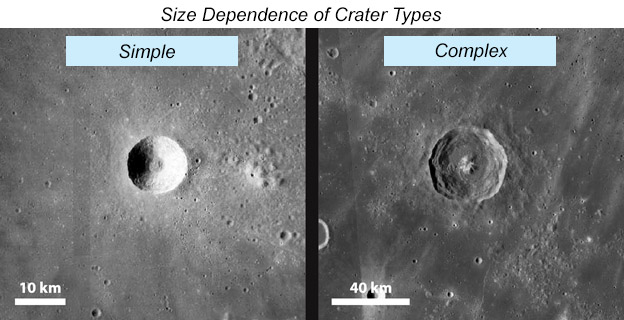In previous posts we’ve discussed how the very smallest craters have “simple” shapes, and that the somewhat larger craters have “complex” shapes. You may have been wondering why that is, and what we mean by “larger” anyway? How large is large? Well, that turns out to be dependent on the planet where the crater is made.
First, a reminder from a previous post about what simple and complex craters look like …

Note that the complex crater is much larger. It has a classic central peak, flat floor, and terraces along the inside rim. (Credit: Trang, D. (August, 2016) What Made the Doughnuts Inside Lunar Concentric Craters? PSRD, http://www.psrd.hawaii.edu/Aug16/Lunar-concentric-craters.html.)
As we measure simple craters on the Moon, for example, we see them getting bigger and bigger until we get to a diameter of about 16 kilometers. Any craters larger that that are complex craters. On Mars we see something different. There the transition is at about 8 kilometers where smaller craters are simple, and larger craters are complex. Why is this?
If we make a plot of this “transition diameter” versus gravity, we see something interesting.

In this plot we see the transition diameter of four worlds plotted against the gravity at the surface of each of those worlds (The Moon, Mercury, Earth, and Mars.). (From LPI/USRA, at https://www.lpi.usra.edu/exploration/education/hsResearch/crateringLab/lab/part1/background/, Credit: Illustration from an educational poster, Geological Effects of Impact Cratering, David A. Kring, NASA Univ. of Arizona Space Imagery Center, 2006.)
Look at the trend in the plot – the data are fit by a line. This trend suggests a direct relationship between the transition diameter and the surface gravity of a planet. We see that Earth, with the highest gravity, also has the smallest transition diameter. The Moon, with the lowest gravity, has the highest transition diameter. This means that simple craters are bigger on the Moon than other bodies before they make this transition to a complex shape. So why is gravity the key in this process?
The bedrock on the surfaces of each these bodies is under constant “stress.” There are forces trying to break or crack the bedrock, and these forces are resisted by the strength of the rock itself. These forces include gravity. During an impact event – a higher gravity means a more dynamic impact process for the creation of the final impact crater.
The larger the impact event, the more that gravity as a force will dominate in the collapse of the crater as it is being formed. For smaller craters, gravity causes small-scale events such as slumping, debris flows, and moving boulders. For larger craters, gravity causes more dynamic changes to the crater such as the formation of a central uplift that creates a peak or peak ring, and slumping of the crater walls into obvious terraces.
Keep watch as you are measuring craters … can you find simple and complex craters near the transition diameter for that world? Is it what you were expecting from the plot above? Did the scientists get it right?




 Join the Crew!
Join the Crew!
 Escape Velocity Space News
Escape Velocity Space News
0 Comments
Trackbacks/Pingbacks